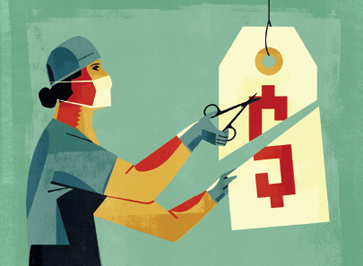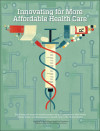 SPONSORED SUPPLEMENT TO SSIR
SPONSORED SUPPLEMENT TO SSIR
Innovating for More Affordable Health Care

This special supplement includes eight articles that explore new ways for social investors to spur innovations that create better, faster, and less expensive health care in the United States. The supplement was sponsored by the California HealthCare Foundation.
My professional life has revolved around a single question: How can doctors and other health professionals catalyze big leaps in the quality and affordability of health care? In keeping with the Physician Charter, a modern version of the Hippocratic oath, many physicians are beginning to realize that they have an ethical imperative to promote “the wise and cost-effective management of limited clinical resources”—in addition to the health of patients.
This ethical imperative has now become a fiscal imperative if the United States is to avoid what has been described in The New England Journal of Medicine as the “specter of financial Armageddon” for federal and state governments. In addition, US workers face a slow strangulation of job and wage growth, and employers who compete in global markets can look forward to years of declining profits.
In my work across the United States, I have observed physician groups and other health care organizations that deliver high-quality care at a cost roughly 20 percent lower than average. Clinicians have the potential to push the value of the US health system to Americans far beyond today’s benchmark. Evidence from the Institute of Medicine of the National Academy of Sciences suggests the possibility of even better care for at least one-third less than Americans are currently spending. But many clinicians are ambivalent about tackling this challenge.
They are not alone. Insurance companies resist competition based on the value of their services. In many markets, insurers also lack the clout to provide incentives to health care providers who approach benchmark levels of quality and efficiency. And consumers are wary of any health system change that may limit their access to care or freedom to choose providers.
In the current climate, none of the players is willing to sufficiently strengthen either the market or the regulatory mechanisms required to improve the value of care. Physicians will be important players in helping to turn around the situation, because they enjoy high levels of public trust and unique power to affect the cost and quality of health care delivery.
A BREAKTHROUGH CARE
To help break the stalemate, I am launching the Stanford Clinical Excellence Research Center (CERC). CERC is devoted to accelerating the discovery, demonstration, and dissemination of innovative models of health care delivery that reduce annual per capita health spending while improving health. Harnessing the power of transdisciplinary innovation will be central to our success.
A historical example may be useful here to show the impact of inventions in care models. In the 1950s and early 1960s, an imaginative physician in Baltimore named Peter Safar realized that outcomes might improve if hospitals centralized the location of their sickest patients and increased the frequency of patient observation and treatment adjustments with a dedicated team. His innovation sparked the evolution of the intensive care unit (ICU). The basic concept then spread to many aspects of hospital care, giving rise to many successful variations on the theme, such as neonatal ICUs, burn units, and surgical ICUs. Hospital mortality for the sickest patients plunged.
The concept of tailoring the design of clinical work to the needs of distinct patient groups continues to inspire hospital improvements. In 2005, I noticed that a similar intensification of care had not been tested for medically unstable patients living at home, beyond nurses’ infrequent case management and generally unsuccessful disease management over the telephone. Over the past several years, I worked with Boeing in Seattle and a union-managed health benefits fund for hotel workers in Atlantic City, N.J., to test a new care model. Funded by the California HealthCare and Robert Wood Johnson foundations and designed by a team of fresh thinkers from four disciplines, we called our model the “ambulatory ICU.” Our A-ICU was designed to reduce markedly the need for emergency hospital care among medically fragile patients. Early results have been impressive, and we are now testing the scalability of A-ICUs in three additional states.
CERC aims to jump-start other new care models for hospitals, as well as for ambulatory care. Each model will target an inflection point in the progression of major health conditions associated with large jumps in future lifetime spending and patient suffering. An illustrative list of such inflection points includes the nine months before and the 24 months after delivery by mothers living in poverty; the transition from obesity to morbid obesity; the first 30 days after discharge from a hospital; and the last phase of life. For example, when an obese patient progresses into morbid obesity, the total future cost of lifetime disability and care increases dramatically.
Approximately one-third of the US population is obese, and approximately 5 percent—or about 15 million people in the United States—is morbidly obese. Morbidly obese adults have seven times the risk of diabetes, six times the risk of hypertension, four times the risk of arthritis, and three times the risk of asthma as patients who are not obese. Health care for both levels of obese patients in the United States costs an estimated $147 billion each year—or more than 5 percent of US health care spending. A more affordable intervention that is as effective as existing treatments and reaches a large proportion of obese people approaching morbid obesity would create enormous health and financial benefits.
Today’s obesity treatments based on behavior change and medication have proven woefully insufficient. Bariatric surgery, on the other hand, is quite effective. A recent employer survey shows that nearly 60 percent of public and private employers now offer some type of bariatric benefit. About 220,000 bariatric surgeries were performed in 2008, and estimates are that the number is increasing at about 20 percent per year.
The problem: The procedure costs more than $30,000 on average. For this and other reasons, the rate of surgery is low relative to the number of people who are likely to benefit. If CERC selects this inflection point as a target, our goal would be a re-engineered form of bariatric surgery that lowers the cost below $15,000, without inventing a new technology or sacrificing clinical outcomes.
Our approach is to embrace such challenges through service-design teams of five or six postdoctoral fellows in residence at Stanford University who represent the disciplines of engineering, business, social science, and medicine. Our methods will borrow the Stanford Biodesign program, which Stanford Professor of Medicine Paul Yock devised with Stanford Graduate School of Business Professor Stefanos Zenios and others to adapt innovation insights from the Stanford School of Engineering’s Design Program to design better medical devices.
The CERC service-design teams will initially train along with Stanford’s Biodesign fellows. Training will focus on the science of innovation design. CERC will also expose the fellows to exceptionally efficient health care organizations so that the fellows design beyond today’s best practices rather than rediscover what’s already working. As they work, diverse faculty will mentor the fellows, subjecting their designs to rigorous review, encouragement, and intellectual challenge.
To ensure that our innovations have a ready test bed, I have recruited health care organizations eager to experiment with highvalue service designs, such as Stanford-affiliated health systems, as well as five to six top-performing health systems outside of California. CERC will assist them in renegotiating payment methods if a new care model requires revised incentives from insurers to be financially sustainable. I have also recruited a national network of large, self-insured employers and large health insurers to offer incentives to test the center’s care models. An active focus on “value-based” payment incentives is crucial to the spread of service-model innovations in which the cost savings and the work to attain them do not naturally accrue to the same party.
INVESTING IN SERVICE INNOVATION
Although Stanford is funding CERC’s startup costs, the center will need to seek additional sources of research investment. A major reason for the lack of speed in improving service design is that service innovations are at a huge disadvantage relative to patentable devices and drugs when competing for investment capital. Unlike new molecules or devices, service models are easily copied public goods. Venture capitalists and other investors turn away societally promising service investments for this reason.
Although the center hopes its models will prove compelling to today’s more cost-focused venture investors, we see an essential role for foundations and other social investors. Many of them are tightly aligned with CERC’s mission to improve both the quality and affordability of US health care.
Just as fledgling companies benefit from their association with venture capital investors, health care design innovators need social investors. They can also play the essential role of polishing the rough edges of service innovations that designers might be too close to see. Staff from the California HealthCare and Robert Wood Johnson foundations played this role in the successful testing and spread of A-ICUs, which are now operating in dozens of US cities. Their involvement also builds interest in testing innovations among payers and providers.
Working together, CERC and social investors can ally with US health systems and payers to test and spread innovative care models. Bending the curve of per capita health-spending growth and improving clinical outcomes are a team sport.
See the complete healthcare supplement.
Support SSIR’s coverage of cross-sector solutions to global challenges.
Help us further the reach of innovative ideas. Donate today.
Read more stories by Arnold Milstein.

